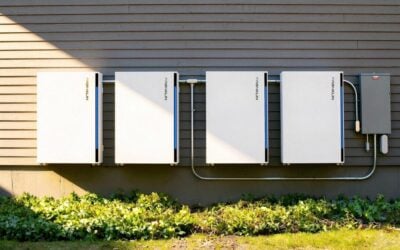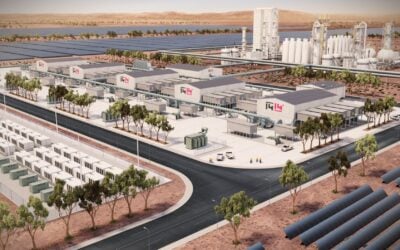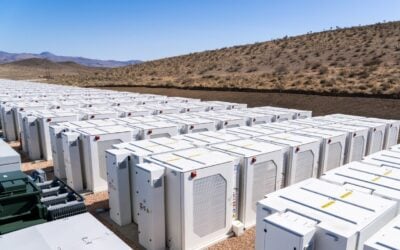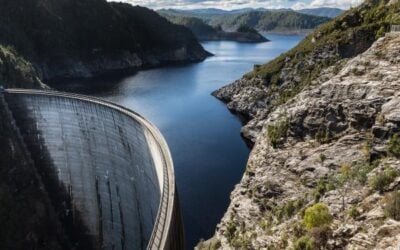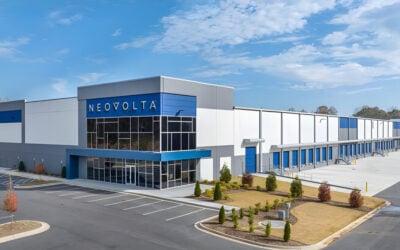Australian tech entrepreneur and Redflow executive chairman Simon Hackett, with ZCell enclosure on screen. Source: Redflow
Australian battery developer Redflow has launched what is thought to be the first residential-level storage device to use a flow battery, in its home market.
The ZCell, unlike its lithium-ion counterparts, is built around a unique zinc-bromine flow battery. It comes in a 10kWh model as standard. The technology enables the ZCell to discharge 100% of its total stored energy, Redflow claims. It is more recyclable than its competitors; its active components being plastic, aluminium and steel. Flow batteries also tend to pose little to no risk of fire hazard on prolonged use.
The durability of the battery is further emphasised through Redflow’s claims that ZCell is expected to deliver its full 10 kWh of stored energy each day for up to 10 years. Its high storage capacity gives the ZCell significant potential to lower power costs, provide power during grid black-outs and support independent energy systems. It is these factors that cause Redflow executive chairman Simon Hackett, the founder of broadband and telecomms company Internode, to believe that ZCell will be a breakthrough system.
“This is one of the first flow batteries targeting the residential area,” said Marianne Boust, principal analyst, IHS Technology.
Try Premium for just $1
- Full premium access for the first month at only $1
- Converts to an annual rate after 30 days unless cancelled
- Cancel anytime during the trial period
Premium Benefits
- Expert industry analysis and interviews
- Digital access to PV Tech Power journal
- Exclusive event discounts
Or get the full Premium subscription right away
Or continue reading this article for free
“It is an interesting product entering the market, as flow batteries tend to be a lot larger [than lithium-ion or lead acid-based systems]. Another advantage is that safety is not as much of a problem.”
Dean Frankel, analyst with Lux Research commented that zinc bromine chemistry could stack up well even in comparison with other flow battery chemistries.
“Zinc-bromine can provide generally more power than your standard flow battery because the reaction is quite high voltage and you can get some good power density.
“Having said that the challenge is the rate at which you can charge the battery at. It’s going to have to be a predictable daily cycle application where it’s not really dynamically responding.”
Demand and reception in Australia
Australia has high electricity prices, while there appears to be a latent desire among the public to be more environmentally astute. There are also region specific drivers for this product in the country, given the long and predictable sunshine hours as well as the cuts made to the premiums paid to homeowners for exporting their solar electricity to the grid – effectively lessening incentives for feed-in tariffs (FiTs).
More than 146,000 homes are set to see their FiT drop from as high as 60C/kWh (US$0.46) to just under 5C/kWh. Demand for home energy storage in Australia has been forecasted to be strong, especially in the wake of these cuts. Also this week, Germany’s residential storage market leader Sonnen announced its launch into the region, while microinverter and energy management specialist Enphase officially opened an R&D centre in neighbouring New Zealand earlier this month.
“Redflow is based in Australia, so it’s their home market but in general Australia’s looking like an attractive energy storage market for a number of reasons,” Dean Frankel said.
“Even across the board they have high electricity rates and we’re talking a lot about residential storage but on the wholesale market they can have pretty serious power spikes,” said Frankel.
Redflow said a fully installed system could be expected to cost between AU$17,500 and $19,000 (US$13,490-14,646). Tesla’s offering to the residential market, Powerwall, is slightly cheaper, retailing at around US$12,000 including PV panels. The price difference in the two is causing analysts to speculate whether ZCell’s premium price tag will be worth it.
“The only question mark we have for this product is on cost,” said Marianne Boust of IHS.
“We are curious to see if Australians will be willing to pay more for this product.”
Although more expensive, at 10kWh per day for 10 years, the ZCell’s claimed storage capacity and lifespan is substantially higher than Powerwall.
Australian residential installations of Redflow’s ZCell are scheduled to start midyear with international availability to be announced.

